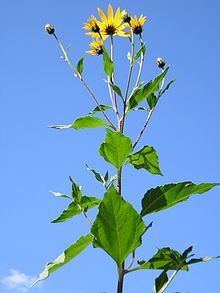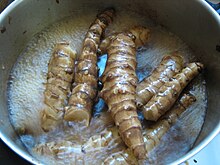| Jerusalem artichoke | |
|---|---|

| |
| Stem with flowers | |

| |
| Jerusalem artichokes cooking | |
| Scientific classification | |
| Kingdom: | Plantae |
| Clade: | Tracheophytes |
| Clade: | Angiosperms |
| Clade: | Eudicots |
| Clade: | Asterids |
| Order: | Asterales |
| Family: | Asteraceae |
| Genus: | Helianthus |
| Species: | H. tuberosus
|
| Binomial name | |
| Helianthus tuberosus | |
| Synonyms[2] | |
| |
The Jerusalem artichoke (Helianthus tuberosus), also called sunroot, sunchoke, wild sunflower,[3] topinambur,[3] or earth apple, is a species of sunflower native to central North America.[4][5] It is cultivated widely across the temperate zone for its tuber, which is used as a root vegetable.[6]
- ^ Rhodes, L. & Maxted, N. (2016). "Helianthus tuberosus". IUCN Red List of Threatened Species. 2016: e.T20694364A20695376. doi:10.2305/IUCN.UK.2016-3.RLTS.T20694364A20695376.en. Retrieved 7 September 2024.
- ^ The Plant List, Helianthus tuberosus L.
- ^ a b Szewczyk, Aleksandra; Zagaja, Mirosław; Bryda, Jarosław; Kosikowska, Urszula; Stępień-Pyśniak, Dagmara; Winiarczyk, Stanisław; Andres-Mach, Marta (22 March 2019). "Topinambur - new possibilities for use in a supplementation diet". Annals of Agricultural and Environmental Medicine. 26 (1): 24–28. doi:10.26444/aaem/102767. ISSN 1898-2263. PMID 30922024.
- ^ "Helianthus tuberosus". County-level distribution map from the North American Plant Atlas (NAPA). Biota of North America Program (BONAP). 2014. Retrieved 26 April 2019.
- ^ "Helianthus tuberosus". Germplasm Resources Information Network. Agricultural Research Service, United States Department of Agriculture. Retrieved 11 December 2017.
- ^ Purdue University Center for New Crops & Plants Products: Helianthus tuberosus
